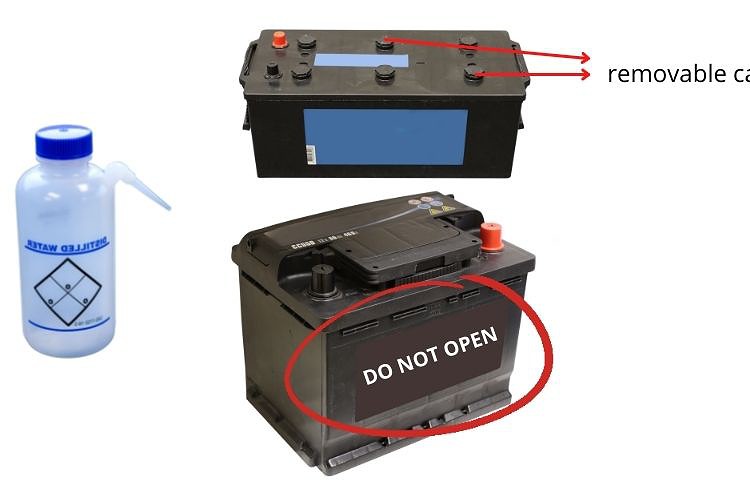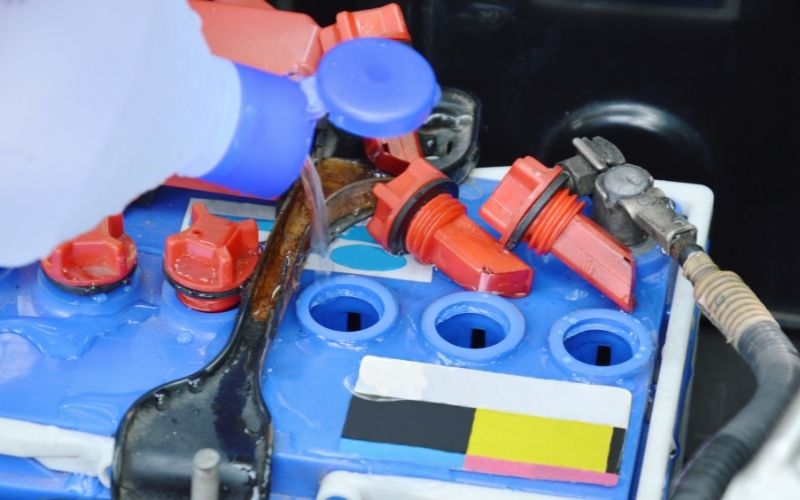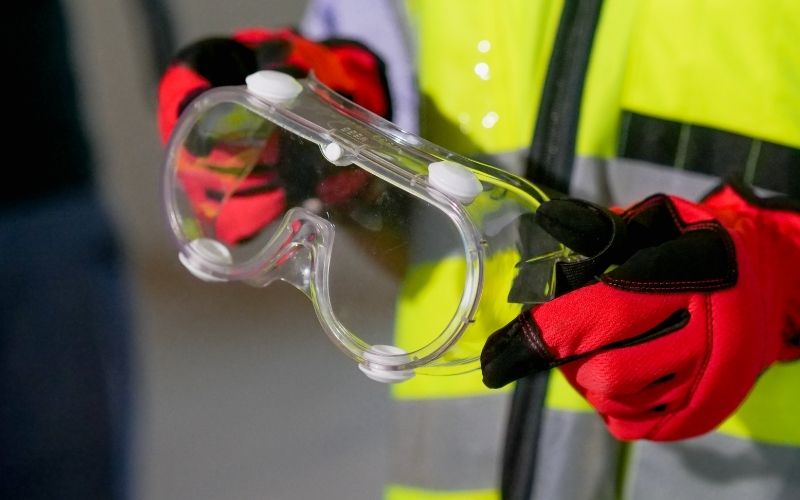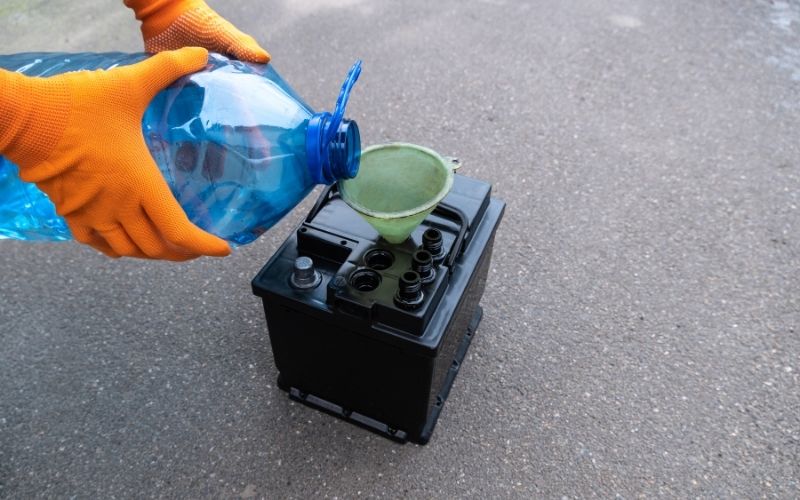Marine batteries generally fall under two broad categories: maintenance-free, and those that require regular maintenance.
If you have a battery that requires maintenance, then one of the things you’ll need to do is add water from time to time. But why is this necessary? And how do you do it?
Keep reading!
In this article, we’ll discuss everything you need to know about checking the water level on your marine battery.
Table of Contents
Do I Need to Add Water to Marine Batteries?
You may have heard that you need to add water to your batteries regularly to keep them functioning properly. But the truth is, there are several different types of marine batteries, and not all of them require the addition of water.
Only flooded lead-acid batteries need water; if you were to add water to other types of batteries, you could damage or destroy them.
Flooded lead-acid batteries hold an electrolyte solution made of sulfuric acid and water. When the battery is charging or powering electronics, this solution heats up and emits fumes through vents in the battery.
Every time fumes are produced and released, some of the water evaporates with them. Once enough water has evaporated, you will need to add more water to replace what has been lost.
It’s important to note that you only need to add water–never sulfuric acid. The correct amount of sulfuric acid will remain in the battery regardless of the fluctuating water levels, so adding more would cause a chemical imbalance that could easily destroy the battery.
Flooded lead-acid batteries should not be confused with sealed lead-acid batteries, which are designed to produce fewer fumes and do not need water added. Sealed lead-acid batteries are sometimes called maintenance-free batteries because you don’t need to add water to them.
There are a couple of different types of sealed lead-acid batteries: AGM and gel.

AGM, or absorbent glass matt batteries, hold all the electrolytes they need in their woven fiberglass matt. They use much less electrolyte than flooded lead-acid batteries and are less likely to leak or spill if damaged.
Gel batteries have the electrolyte in a gel rather than a fluid. Gel batteries last longer than even properly-maintained flooded lead-acid batteries because it takes a long time for all the gel to be used up.
Both AGM and gel batteries would be damaged if you attempted to add water to them, as they are not designed for this additional fluid in their cell chambers.
Another type of battery, the lithium battery, is also considered maintenance-free, but it is different from the other kinds of batteries discussed above.
Lithium batteries do not need water; in fact, they don’t even use battery acid. They are powered by electrons moving through a different type of electrolyte. They generally last much longer than lead-acid batteries but are also much more expensive.
How Do I Know if My Battery Needs Water?

If you’re not sure what type of battery you have, check for removable caps or covers on the top of the battery. There should be one cap for each cell. If the battery has these caps, it is a flooded lead-acid battery and you will need to add water regularly.
It’s also a good idea to check any labels on the battery. Warnings such as “DO NOT OPEN” would indicate a sealed lead-acid battery that doesn’t need water added.
On the other hand, labels regarding adding water, replacing vent caps, or other such maintenance instructions would indicate a flooded lead-acid battery. It’s important to follow any instructions in your battery’s warning labels.
If you have a flooded lead-acid battery, you’ll need to visually inspect water levels. We’ll discuss how to do that below.
Some batteries may have a fill line, while others may not. Regardless, the water in each cell chamber should completely cover the lead plates inside, but should not come all the way up into the fill tubes.
A good rule of thumb is that battery cells should be covered by about ¾ inch of water, and the water should reach the bottom part of the vent.
How Often Should I Add Water to My Marine Battery?

How often you water your battery will depend on how often you use it. If you rarely use the battery, you may only need to add water every six months. If you use it more frequently, you may have to add water once a month, or even once a week.
Hot weather will also increase the need for adding water, as the water will heat up and evaporate more easily.
You should check the battery often as part of its regular maintenance. If you’re not sure how often to add water, check your fluid levels every time you use the battery for a while to get an idea how quickly it uses water.
How to Check the Marine Battery Water Level?
If you’ve never checked a battery’s water level before, it may help to get a good visual of the process before starting. Check out the following video:
Follow the steps below:
- Clean the battery. Before opening up your battery, it’s important to make sure the exterior is thoroughly clean. Wipe away all dust, grime, bits of debris, and insects so that they don’t end up inside your battery cells once you open them.
- Inspect and clean terminals. This is also a good time to remove any corrosion or buildup around your battery’s terminals. You want them to be clean along with the rest of the battery’s exterior so no foreign matter drops into your open battery cells.
- Carefully remove the caps. There should be one for each battery chamber. Depending on the design of the battery, you may need to simply unscrew them, or you may have to pry them off with a flathead screwdriver.
- Inspect the water levels. Look down into each chamber to see how much water there is inside. Again, the water should be completely covering the lead battery cell, but you don’t want it to the top of the chamber.
- Add water if necessary. If any of the cells are not covered with water, or if there is too much gap between the waterline and the top of the chamber, add an appropriate amount of water.
If your battery isn’t fully charged at the inspection time, add just enough to cover any exposed cells, then charge the battery before filling.
Tips for Adding Water to Your Marine Battery

- Wear protective equipment. You should never open up your battery before putting on a pair of rubber gloves and some form of eye protection . Getting battery acid on yourself can cause severe injury, so handle your battery with care.
- Follow warning labels. As noted above, you won’t want to disregard any warnings or instructive messages found on your battery’s label. Always read the label before opening your battery for the first time.
- Keep it clean. Dirt or grime on the outside of your battery can easily get inside any open battery chambers, contaminating the electrolyte and shortening your battery’s lifespan. This is why it’s important to always clean the battery before opening it.
- Check water levels before and after charging. If possible, only add water when the battery is fully charged.
If the battery isn’t charged but some of the cells are exposed, you will have to add water before charging, but only enough to allow for a proper charge. Once the battery is charged, you may add the appropriate amount of water to fill the chambers. - Use only deionized water. It is best to use distilled water in your battery because it is pure and free from minerals and additives.
Don’t use tap water, as some of the minerals and other things in the water can affect the chemical balance of the electrolyte. This can, in turn, significantly shorten the lifespan of your battery. - Avoid overwatering. You should never fill the chamber to the top because the electrolyte will expand as it heats up. If there is no headspace for the expanding solution, the battery will sustain damage and may even explode.
- Use a syringe or funnel. Usually, the openings into each battery chamber are small. It can be difficult to pour water down these openings without spilling, but spilling too much water on the battery may cause damage.
To make sure the water goes exactly where you’re intending it to go, pour it through a funnel , or use a large syringe to pump it down into the chambers.
Conclusion
Knowing how to check the water level is an important skill if you have a flooded lead-acid marine battery. Hopefully, after reading this article, you’ll better understand how to check the water level, how to add water if necessary, and why adding water is important.

Sarah Hood has been writing for Anchor Travel since 2021. When she’s not writing, she enjoys cooking, singing, and spending time in the great outdoors.

